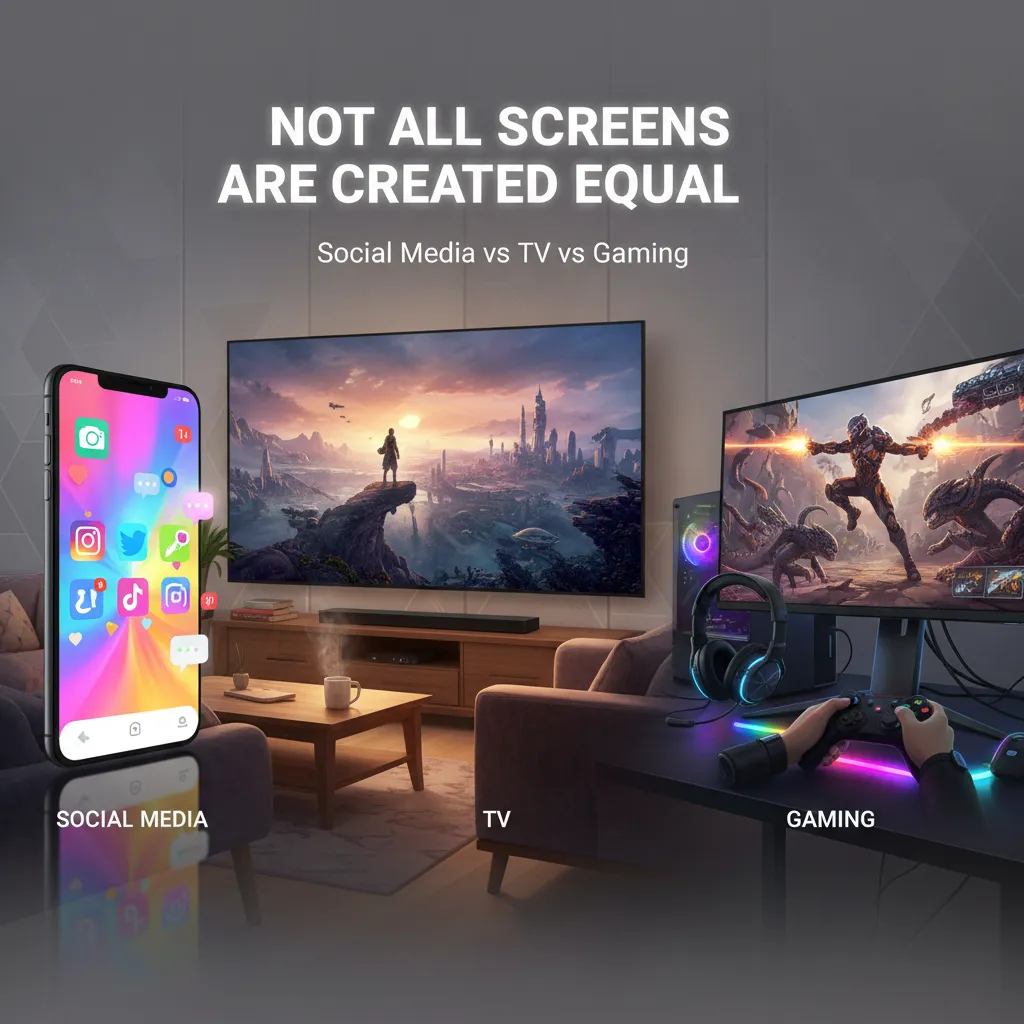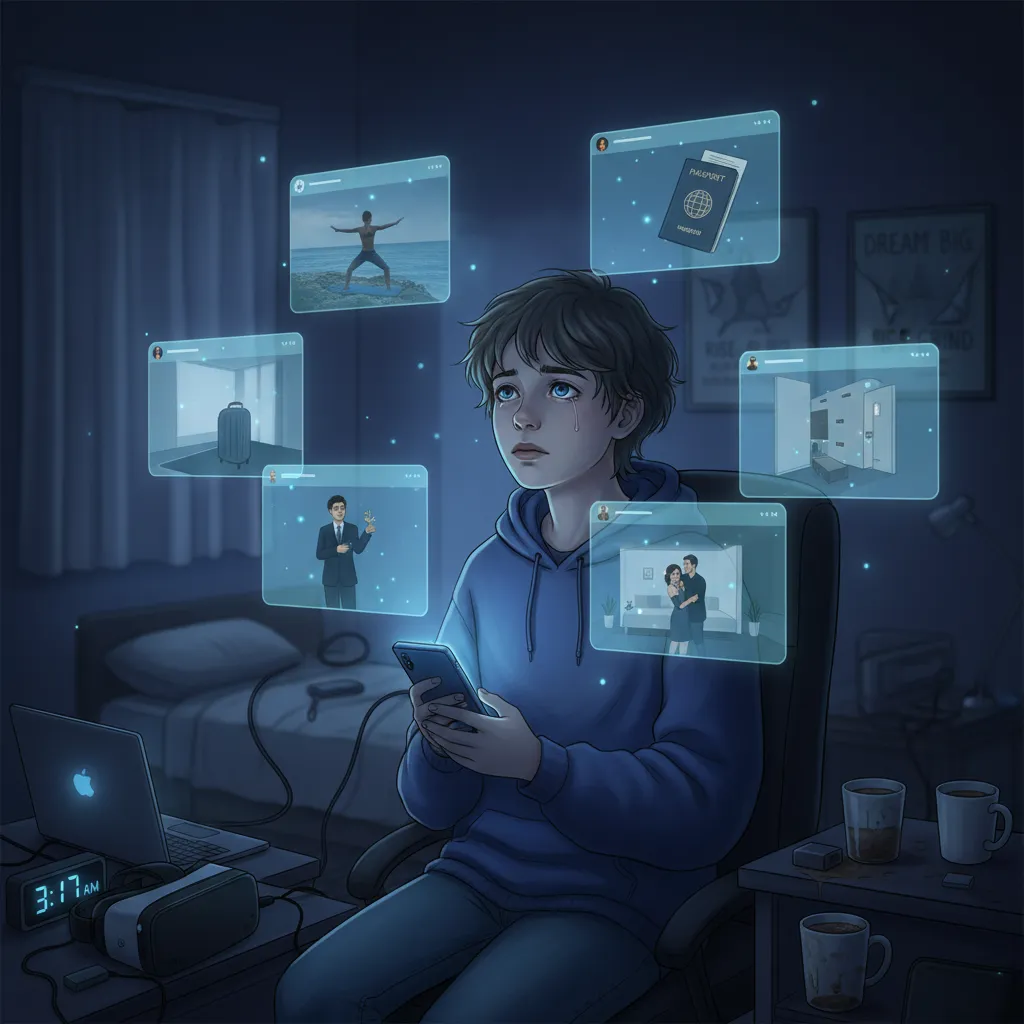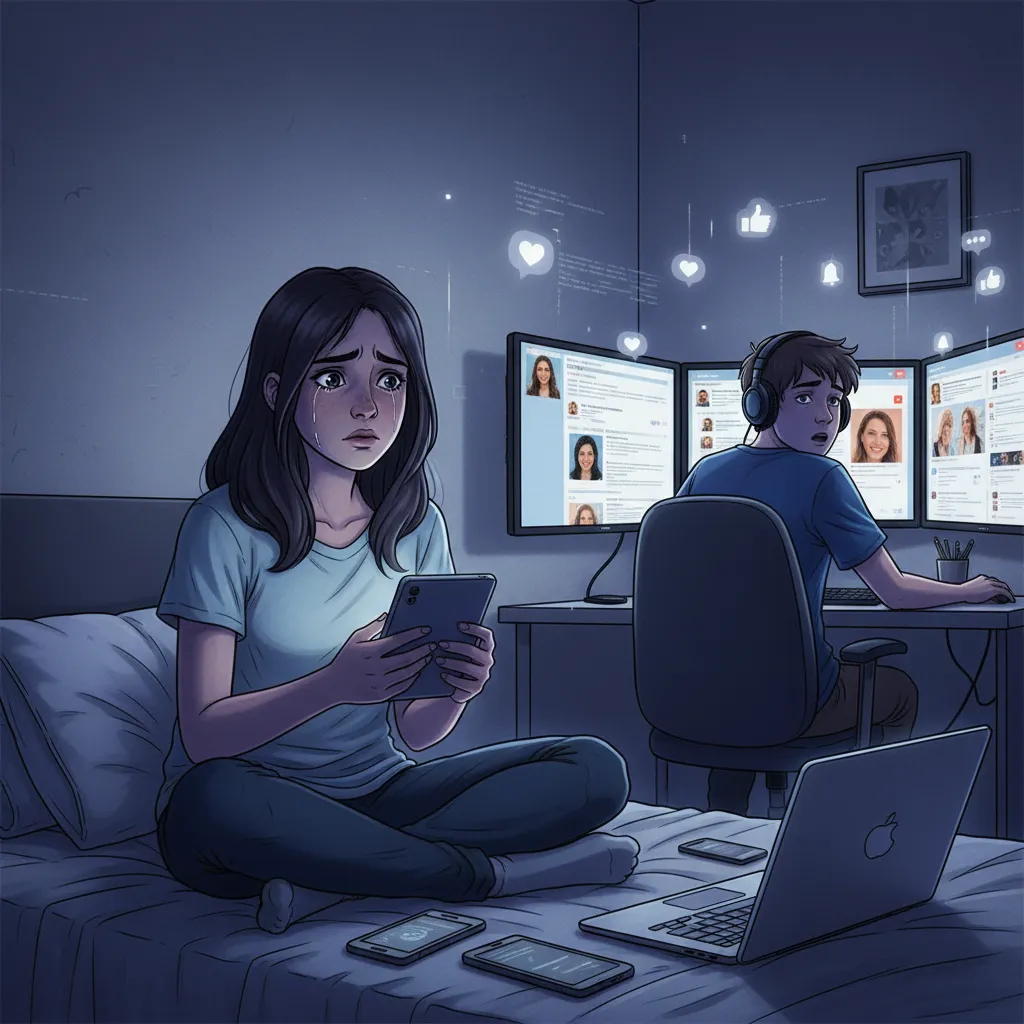When my youngest niece, all of ten years old, gave me a detailed pitch for her Instagram account, I realized the world had changed since dial-up internet and Tamagotchis. Parents today face questions we never had to ask: Is an hour of TikTok the same as an hour of TV? Why does my son seem blue after scrolling social feeds, but not after gaming? Let’s get real about what the science—and lived experience—suggests about how screen time is affecting our youth.
Not All Screens Are Created Equal: Social Media vs TV vs Gaming
When it comes to the effects of screen time on youth, not all screens have the same impact. Recent research involving nearly 4,000 students from seventh to 11th grade has revealed that the type of screen matters—a lot. The study, which set out to understand the relationship between different screen-based activities and mental health, found that social media depression in teenagers is a much bigger concern than the effects of television or video gaming. Let’s break down what this means for teens and their families.
Social Media: The Strongest Link to Depression
The most striking finding from the study is how much more strongly social media use is linked to feelings of sadness and loneliness in teens compared to other types of screen time. For every additional hour spent scrolling through social feeds, young people reported higher rates of feeling lonely, sad, or hopeless. This connection was much more pronounced than with other screen-based activities.
As Dr. David Anderson, a clinical psychologist at the Child Mind Institute, explained:
"It's not necessarily the social media or screens were causing depression, but they found a pretty strong link between one type of screen time."
This means that while screens themselves aren’t automatically harmful, how teens use them—and which platforms they use—matters a great deal. The study’s data showed that screen time effects on youth are not universal; social media stands out as the platform most closely associated with negative mental health outcomes.
Television: A Weaker Association with Sadness
Television has long been a staple of adolescent entertainment, but the study found that its impact on mental health is not as severe as that of social media. While increased TV watching was linked to some feelings of sadness or loneliness, the association was much weaker. Teens who spent extra time watching TV did not report the same sharp rise in depressive symptoms as those who spent more time on social media.
This suggests that not all passive screen time is equally risky. The difference may be in the nature of the activity: TV is often a shared family experience or a way to unwind, while social media can invite comparison, exclusion, and cyberbullying—all factors that can worsen feelings of isolation.
Video Gaming: Less Tied to Depression Than Social Media
Video gaming, another popular screen activity among teens, also showed a weaker link to depression compared to social media. While some parents worry about the effects of gaming, the research indicates that, on average, gaming does not increase feelings of sadness or hopelessness as much as social media does.
In fact, for some teens, gaming can be a social outlet, offering opportunities for teamwork and connection. Of course, excessive gaming can still pose risks, but when it comes to video gaming depressive symptoms, the study suggests these are less pronounced than those linked to social media use.
Why Is Social Media More Harmful?
So, why does social media have a stronger connection to depression and loneliness in teenagers? Researchers believe it’s because social media platforms are designed for constant interaction and comparison. Teens are exposed to carefully curated images and updates from peers, which can lead to feelings of inadequacy or exclusion. The pressure to keep up, respond quickly, and gain approval through likes and comments can be overwhelming.
In contrast, TV and video games are less interactive in this way. They don’t usually require the same level of social comparison or instant feedback, which may explain why their impact on television adolescent mental health and gaming-related depressive symptoms is less severe.
Key Takeaways from the Study
- Study size: Nearly 4,000 students, grades 7 to 11
- Social media: Most strongly linked to feelings of sadness, loneliness, and hopelessness
- Television and video games: Showed a much weaker association with depression symptoms
- Platform matters: Not all screen time is equal—social media stands out as the riskiest for teen mental health
Understanding these differences can help parents, educators, and teens themselves make more informed choices about how they spend their screen time. While all screens should be used in moderation, it’s clear that social media depression in teenagers is a unique and pressing concern compared to other digital activities.

Why Does Social Media Sting? The Power of Comparison and Displacement
When you scroll through social media, it’s easy to feel like everyone else is living a happier, more exciting life. This isn’t just your imagination—researchers have found that social media risks teens by amplifying the urge to compare yourself to others. This constant comparison can have a real impact on your mood and mental health, especially for teens already struggling with depression.
"Social media may be most injurious to teens with depression, partly because of the comparisons you're making online to other people's lives." – Dr. David Anderson
Social Comparison: The Highlight Reel Effect
Social media platforms are designed to showcase the best moments of people’s lives. You see friends posting about vacations, achievements, and fun times, but rarely about their struggles or bad days. This creates what experts call the “highlight reel effect.” When you compare your everyday life to someone else’s curated feed, it can make your own experiences feel less exciting or even inadequate.
- Curated content: People post their happiest moments, not their real, everyday struggles.
- Unrealistic standards: Constant exposure to filtered images and achievements can make you feel like you’re falling behind.
- Emotional impact: This comparison can lower self-esteem and increase feelings of sadness or anxiety.
For teens who are already feeling low, these comparisons can be especially harmful. The more you see others looking happy and successful, the more you might believe that you’re missing out or not measuring up. This is a key reason why screen time and depression are so closely linked in recent studies.
Displacement Theory: What Are You Missing?
Another important idea is displacement theory. This theory says that the more time you spend on screens, the less time you have for activities that actually boost your psychological well-being. It’s not just about what you’re seeing online—it’s also about what you’re missing out on in real life.
- School and learning: Excessive screen time can eat into time needed for homework and studying.
- Friendships: Real-life interactions help build strong, supportive relationships.
- Family time: Shared meals, conversations, and activities with family are key for emotional health.
- Extracurriculars: Sports, clubs, and hobbies provide a sense of accomplishment and belonging.
When these important activities are pushed aside by endless scrolling, teens can become more vulnerable to depression and anxiety. The study highlights that “you want to check off developmentally important boxes, you want to make sure kids are succeeding in school, doing their homework, that they have extracurricular activities, quality friendships and some family time that doesn't involve screens.” This is the foundation of displacement theory management—making sure screen time doesn’t crowd out what matters most.
The Feedback Loop: Lonely, Online, and Back Again
One of the most troubling patterns researchers have noticed is the feedback loop many teens fall into. If you’re feeling lonely or left out, it’s natural to reach for your phone and check social media. But instead of feeling better, you might end up feeling worse after seeing everyone else’s “perfect” lives. This can lead to even more screen time, deepening feelings of isolation and sadness.
- Feel lonely → Turn to social media for connection.
- See curated, happy posts → Feel even lonelier or less satisfied.
- Repeat the cycle → Increased risk of depression and anxiety.
This cycle is why experts say that psychological well-being and screen time are closely connected. It’s not just the amount of time spent online, but how that time replaces real-world experiences and fuels negative self-comparisons.
Finding Balance: What Can Parents and Teens Do?
It’s not realistic—or even necessary—to eliminate screen time altogether. Instead, the goal is to find a healthy balance. Parents can help by encouraging activities that support psychological health and by talking openly about the risks of social media comparison. Make sure there’s time in each day for schoolwork, hobbies, friends, and family—without screens. When social media is just one part of a full, active life, its sting is much less likely to leave a lasting mark.

The Parent Paradox: Standing Guard Without Smothering
As a parent in the digital age, you face a challenge that previous generations never imagined: guiding your child through the complex world of social media and screen time. There’s no official curriculum or user manual for this role. The rules are being written in real time, often by trial and error. But one thing is clear—when it comes to parental guidance for screen time and monitoring social media use, your involvement matters far more than any blanket ban or strict prohibition.
Many parents worry about the effects of screen media use on their teens’ mental health. It’s easy to feel overwhelmed, especially when children start asking for social media accounts as early as elementary school. But research shows that active parental monitoring and open dialogue can actually reduce the mental health risks associated with excessive screen time. The goal is not to eliminate screens from your child’s life, but to help them develop healthy habits and digital literacy that will serve them well into adulthood.
Think of your child’s device as a library book—something to be checked out, used responsibly, and returned for review and discussion. This approach allows you to supervise their online activities without making them feel like you’re constantly watching over their shoulder. By “checking out” devices, you create natural opportunities to talk about what they’re doing online, who they’re interacting with, and how they’re feeling about their experiences. These conversations help build trust and accountability, and they teach your child how to make good decisions when you’re not around.
Setting boundaries is another key part of finding a healthy screen time balance. It’s important to establish clear rules about when and where devices can be used, and to enforce consequences if those rules are broken. But it’s equally important to explain the reasons behind your rules. When your child understands that your goal is to keep them safe and help them grow, they’re more likely to respect your decisions and come to you with problems.
Of course, monitoring social media use doesn’t mean reading every message or post. Instead, focus on being present and engaged. Ask your child about their favorite apps, the friends they interact with, and the content they enjoy. Show genuine interest in their digital world, and try to ally with it rather than criticize it. As Dr. David Anderson puts it,
"You want to find ways they can be online in a healthy way, and ways that you can try to kind of ally with their world rather than criticizing it."This approach fosters open communication and helps your child feel supported, not judged.
It’s also important to remember that screens should never take priority over real-life connections, academic responsibilities, or quality family time. Encourage your child to spend time with friends in person, pursue hobbies, and stay engaged in school. When these areas of life are thriving, the negative effects of screen media use are less likely to take hold.
Ultimately, the parent paradox is about finding the right balance between standing guard and giving your child the freedom to learn and grow. There’s no one-size-fits-all solution, but your involvement—through supervision, education, and shared rules—makes all the difference. By monitoring and discussing screen habits, you empower your child to use technology in healthy, positive ways.
As you navigate this journey, remember that you’re not alone. Every parent is learning as they go, and every family will find their own rhythm. What matters most is your willingness to stay engaged, keep the conversation going, and adapt as your child grows. With thoughtful parental guidance for screen time and a commitment to open dialogue, you can help your teen thrive—both online and off.
TL;DR: More screen time, especially on social media, is tied to greater depression and loneliness in teens. Not all screen time is equally harmful, and active parental involvement makes all the difference. Balance and boundaries are key.



